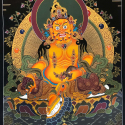Description
Dzambala with Vajrasattva Thangka is hand-painted in Cotton Canvas in Kathmandu, Nepal. The size of this thangka is 65 x 49cm and its weight is 0.1kg. In Hindushim, it is also called Kubera.
Dzambala is depicted in the center of the thangka. Vajrasattva is presented at the top of Dzambala in the thangka. It is pronounced like Yellow Jambhala. It is painted Jambhala Thangka is the god of prosperity in Buddhism and helps to eradicate poverty.
Iconography of Dzambala
Dzambala is considered the most popular and powerful Wealth of God. He is the emanation of Buddha Ratnasambhava. He can remove poverty within the six realms, increasing virtues, life span, and wisdom.
He is also said to be an emanation of Vaisravana, one of the “Four Great World-protecting Heavenly Kings”. He is the guardian of light in Buddhism, a great charitable deity who grants fortune and protection. Lord Vaisravana lives in the northern region under the Four Heavens, at the northern crystal palace on the fourth level of Mount Sumeru.
According to the commentary on Lotus Sutra, this heavenly king is extremely knowledgeable as his perpetual protection of the Buddhas has enabled him to receive many teachings. Yellow Jambhala has a yellow-colored body, he sits in the vajra position with his right leg is panhandle, his right foot is above a snail and lotus flower, and his left leg is kinked. He has one face and two arms. His left hand holding a mongoose named Nehulay which spews forth precious jewels from its mouth, while his right hand holding gems-shaped fruit and leaf of a lotus.
An ordinary image of Lord Vaisravana is one that holds a precious pagoda in the left, which pours out various treasures. In Tibetan Tantric images, the precious pagoda is replaced by the treasure-emitting mongoose. Yellow Jambhala sits on a lotus, sun disk, and moon disk.
Mantra of Dzambala
The mantra of Dzambala is Om Jambhala Jalendraye Svaha.
Iconography of Vajrasattva
Vajrasattva is presented at the top of Dzambala in the thangka. Vajrasattva is pure white in color and is sometimes known as the Prince of Purity. His name means “Adamantine Being”, or more poetically “Embodying Reality”.
He is a member of the Vajra family of Aksobhya which also includes Vajrapani. He is depicted as a young man in the prime of life, with all the silks and jewels of a wealthy prince.
In his right hand, he delicately balances a vajra at his heart. In his left hand, he holds a bell at his waist. The vajra represents Reality, and Compassion; while the bell represents Wisdom.
Vajrasattva is said to have been originated from the seed syllable Hum and is generally invoked for removal of obscuration of Kleshavarana and Jneya Avarana.
His hundred syllable mantra is very efficacious in purifying our defilements through confession practice. It is said if confession is done with the four opponent powers, then non-virtuous actions or obscurations will be purified.
The first opponent power is the force of reliance. This means looking upon the visualized image of Vajrasattva as the embodiment of one refuge. The second opponent power is the sincere regret for the non-virtuous action done by oneself.
The third opponent power is desisting from evil deeds. The fourth opponent power is to apply the power of good deeds; and especially regarding this case, practicing the meditation and recitation of Vajrasattva without parting from Bodhicitta while remaining in the state of emptiness.
Vajrasattva is a very popular tutelary deity for Nepalese Vajracharya. He is worshipped very often by Nepalese Buddhists through the Guru Mandala ritual.
In some mandalas Vajrasattva represents the Adi Buddha or the Primordial Principle of Buddhahood in others, he changes places with Aksobhya in the East.
In Shingon Buddhism it is Vajrasattva that passes on the initiation of the Dharmakāya Buddha Mahāvairocana to Nagarjuna, thereby creating the Vajrayana lineage.
Mantra of Vajrasattva
The mantra of Vajrasattva is Om Vajrasattva Hum.






































Reviews
There are no reviews yet.